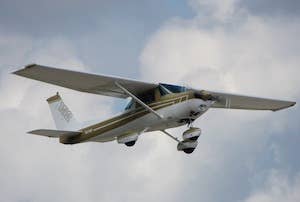
For many licensed and student pilots, a checkride is a nerve-wracking event even if everything goes as planned. Last weekend an unfortunate pilot had his Private Pilot checkride turn into an actual emergency when two propeller blades separated from his Sting Sport LSA. Fortunately the pilot made a successful emergency landing and walked away uninjured with his Private Pilot License (PPL). But what would you do if you experienced an emergency during a checkride?
The first thing you need to do is to forget about the checkride aspect of the flight. It’s important to know that equipment malfunction qualifies the pilot certificate applicant for a letter of discontinuance. This means that you can continue the checkride at a later date without having to repeat the maneuvers you already completed and without having a failure on your record. So your last thought should be whether you’re going to pass your checkride or not just because you experienced a systems failure of some kind.
It’s also critical to know who’s in charge. Per FAR 61.47, the applicant for the rating will act as the pilot in command (PIC), not the examiner "unless the examiner agrees to act in that capacity". So even if it’s your initial pilot checkride (for the Recreational, Sport or Private Certificate), you’re in charge. Some examiners announce in their pre-exam briefing that they will take the role of PIC if any type of emergency were to arise. If your examiner doesn’t specify this, you should develop an emergency plan of action with the examiner. The checkride may be the first time you’ve met your examiner, so it is even more important that both of you understand what your roles should be in case of an emergency before you jump into the airplane.
It’s logical that the most experienced pilot would act as PIC when an emergency happens. And in the case of your initial flight test, your examiner will most definitely have more experience than you, so it may make sense that he or she takes over as PIC in case of an emergency. During checkrides for more advanced ratings, it is conceivable that you have more experience than the examiner in the airplane you're using for the exam, so in such cases a good discussion about who should take responsibility is very important.
If you’ve determined that the examiner will be in charge, you can help out by reading any pertinent checklists or other information in the POH and looking for traffic. If you’ve both agreed that you will act as the pilot in command in case of an emergency, focus on the task at hand. Follow the procedures you’ve been trained for and get your examiner to help by reading the checklists. It appears that the Sting Sport pilot did a great job of managing his unfortunate event, earning the respect of the examiner and his PPL in the process. But if you are have trouble dealing with the emergency, I’m certain that you and the examiner will agree that it’s time for the examiner to take charge of the situation.

Sign-up for newsletters & special offers!
Get the latest FLYING stories & special offers delivered directly to your inbox






